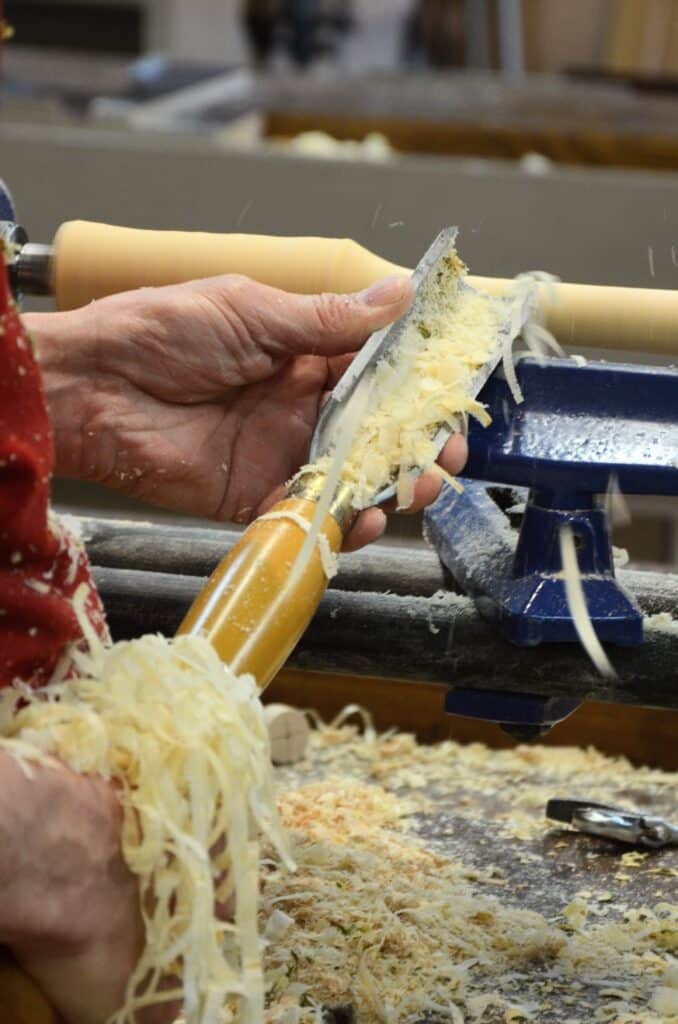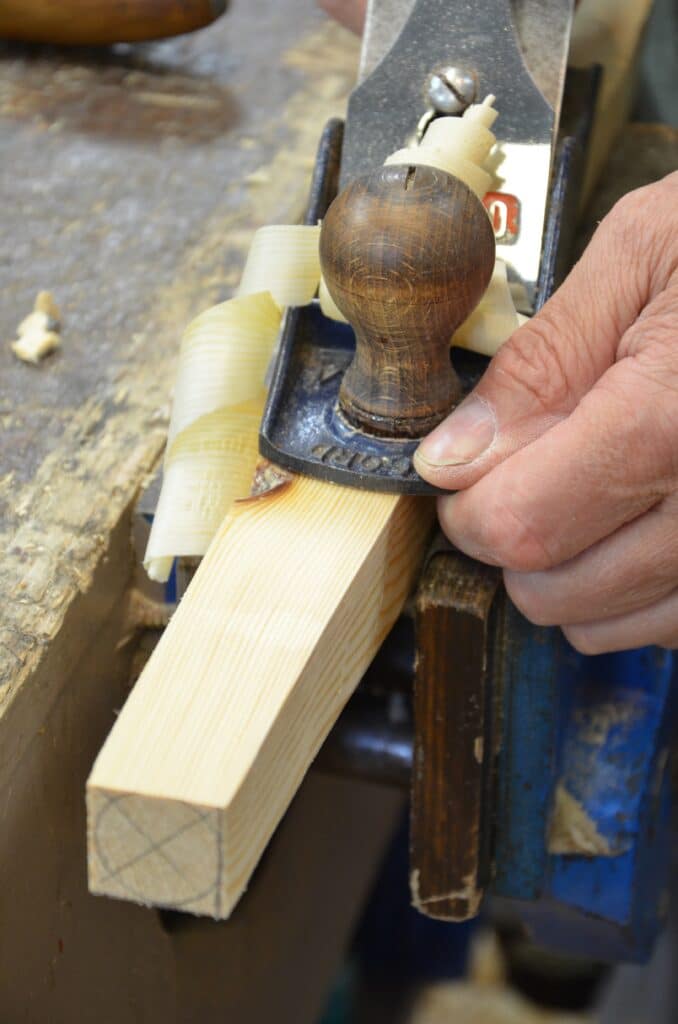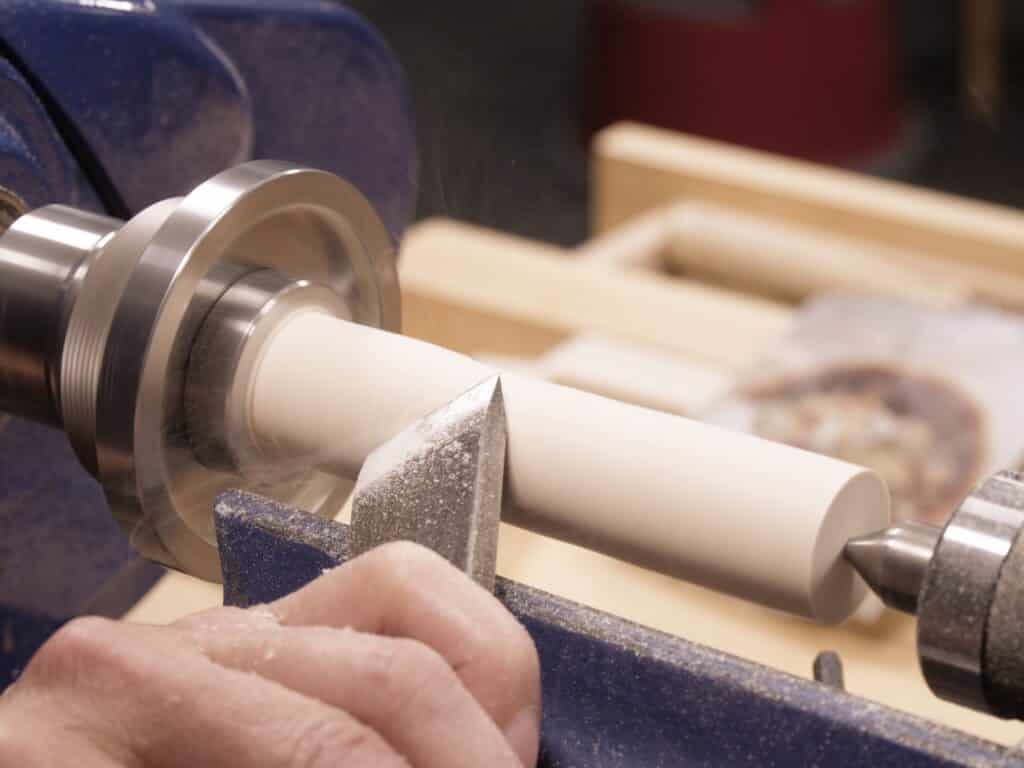My Book: A Life of Woodworking
Recovery
The opening days of my woodworking
School and School Woodworking
Part II
How it all began
The lathe whirred and the wood wafted the surface dust from the lathe bed upwards in billowing, spinning powdered waste like the sand rolling ahead of a Texas desert breeze. The quietness of the motor surprised me as much as the power of its turning the blank between centres distorted the squared-cornered section into a hologram of filled-unfilled and transparent space. This was to be my first encounter with the unique sphere of woodworking, the demonstration by a man who knew the best way to manipulate gouges, parting tools and then the half-inch skew too was mesmerising. My then new-to-me teacher, Mr Hope, gave a knot of fifteen boys a demonstration of woodturning between centres by creating an endless series of coves and beads in a solid of wood in a matter of seconds using but one, bright steel gouge. I don’t think the others in the circle around the lathe felt the same way I did — this was no longer playtime for me, but they continued goofing around.

I felt an unwritten, unspoken invitation that was somehow all-infusive. That spinning blank of rectangular wood transformed from square to round simply by the spinning of it. The hard corners spun out into oblivion in a split second, grabbed my whole being. As my teacher lowered the gouge to the tool rest I watched mesmerised by a perfect cove forming in perfect symmetry a matter of feet from my eyes. Inwardly I was captivated and outwardly that curved shape was shaping me in a way I never knew possible. There and then it showed me that wood could be turned from useless clunkiness to total functionality and all in a matter of three or four minutes. It was the simplicity that made turning seem so invitingly simple. Watching it done by someone able took what seemed impossible before that mesmerizing moment into the realms of ultimate possibility. I knew then that I could do it. I could make something neat and lovely and meaningful and it would take only a matter of minutes. Watching the ribbons rise and cascade like fireworks without sound somehow ignited in me a simple spark. I knew I was alive to this more than anything I had known in school before and that this was something simply called woodworking.

Mr Hope’s more sallow complexion and his casual demeanour belied an inner vitality I had yet to witness in any of the teachers I had come to know. Thin-faced, slightly built and angular throughout his body, he carried himself in a slow-paced faltering gait without the precise movements you might expect from a man his age. He was too young to move so, but it made no difference to his abilities in working wood. I liked the enthusiasm he brought to my life at this pivotal point. His tweed jacket with its leather-patched elbows of soft suede sagged from his thin frame like an old canvas tent. The image aged him all the more but somehow he exuded a warmth in his eyes from beneath his gold-rimmed glasses that magnified them tenfold. His glasses, perched precariously on the low point of his pointed nose, made him look over the top of his glasses for the farther away distances. He was the newest teacher in the school and he was also new to teaching woodworking. It was here in this class that I first encountered teacher enthusiasm. All others were dyed-in-the-wool teachers aged by their profession and not by the years lived. I learned there and then that enthusiasm is everything, a very powerfully effusive mannerism and to any willing recipient it’s always infectious. All of the boys were captivated by this unusually physical work. No desks, paper and ballpoint pens here. And I think it was here then that I first discovered that there was very little physical activity in the other parts of school; a strange example of work if you think about it, when you think that even now half the population at least is engaged in working physically in the multidimensional world of working yet in schools there really is almost no example of working manually. No other lessons beyond the physical education of sports required bodily output beyond sitting at a desk for hours in a day. Whereas sport has always seemed to me more a waste of space, practical hands-on craftwork, no matter the type, filled me with constant delight and still does to this day in the 60 or so years of my doing it full time.

Mr Hope had previously changed from joinery work to become a teacher through his training at Loughborough teacher training college. This alone had given him a new world to live and thrive in. In minutes he twisted and turned the gouge in, out and over to show how quickly a rolling pin could be turned from a square section of wood on a lathe — handles were formed to fit the hands in two quick manipulations and it was these manipulations that so piqued my interest. My delight met his enthusiasm full on and I felt a symbiosis I had not felt since I was in primary school at eight or nine.

In my school days, 1955 to 1965, shorts were for children and long pants were the demarcation starting manhood. I felt like the short-trousered child being tipped into the long-trousered world where something called adulthood began; I was about to do something so totally grown-up for the first time. It was a machine that made the difference and I was about to use one. The wood, held between two points, was as my life, suspended between the points of childhood and adulthood. The gouge was the tool that would add shape and character and my taking the billet from square to round was the defining of growth. The theory was at least good, the intrigue held me in a place of fascination, of anticipation, of future. Mr Hope’s bony hands did express his experience that showed me what was at least possible; that was all I needed.
I’m not sure what intrigued me from then on but mostly it was the effortlessness exuded by the magician in control of his audience. In just two minutes and what seemed to me a single sweeping pass from left to right, my introduction to something I never knew possible was complete. Soon I would have my turn on that lathe. This, his simple dextrous movement with the gouge, mesmerised me. With the wood spinning in high-speed suspension between head and tailstock, my fascination grew. Shavings spiralled upwards like a sky-filled fireworks display to a rhythmic background whir of wind, the vibration of the motor, the wood and the gouge. The long plumes of ash twisted as swirls upwards, stopped midair and then spiralled softly and slowly to the floor. But right then, when a boy was talking instead of watching, Mr hope seemed apt to skew the gouge and direct those spirals into the ever-open mouth of the recalcitrant. Even that action showed the measured control the master had. Nonetheless, when Mr Hope asked who wanted to be first, my hand had shot skyward ahead of all others — I did not want to miss the start of this journey. He took me first to the bench, handed me a bench plane, a No 4 Stanley, and showed me where to plane. Drawing 8 lines along the length of the billet using his finger as a joiner’s finger gauge, he placed it in the vice and gave me my first lesson with the plane. In fits and starts, I removed the corners down close to and in some cases beyond those guidelines. Amazingly I formed my first octagon shape 20” long. It took most of the lesson, but with his assisting along the way, I was ready for the lathe.


Sooo… a machine played a part in you becoming a woodworker, eh? 🙂
Just a joke, Paul. 🙂 In lower secondary school, I got to experience the lathe myself. Until then, my sloyd lessons in school were more arts and crafts than anything else.
But the lathe was really fun, and I did a lot of it. It sparked my interest in woodworking. But after 9th grade, the lathe and I parted way. No more woodworking for many, many years. Until the interest was reignited and I started dreaming about table saws, spindle sanders and stuff like that.
Then I saw a video of a man flailing about with a hand plane on a lawn at some wood propped up against a tree… “I think I can do that too!” I thought.
I could.
Mr. Hays, Parkway Jr. High School, 1963.
Thanks for sharing Paul. In some ways, my discovering your YouTube video where you did dovetails had a similar click for me. I knew I wanted to woodwork. I thought I would be using machines. Since I needed to save for the machines, I was starting to do some research. Since dovetails are often associated with quality craftmanship, I started learning online how to make them and came across your video. It all clicked and right then and there, decided this is how I would woodwork with hand tools.
My career as an organic chemist was similar as well. I wanted to be a scientist and settled on chemistry but that is still very broad. When I took my class in organic chemistry, I immediately knew this is what I must do with the rest of my life. That was 1987 and am still as passionate about it today, if not more so.
Very odd how when you know, you know. I tell my chemistry students (I teach one night a week for fun), that they should be open minded to all the classes they “have” to take. They think they know what they want to do BUT you never know if a certain class will give them a spark or passion that completely changes their mind.
My son and now my granddaughter took an intro to woodworking class in junior high school. Both built the requisite birdhouse. We still have John’s but it’s a bit tattered after 30 years. Isabelle really excelled in birdhouses.
Mr. Raymond, Country Day School, 1963-65. My parents put me in a private school in 7th grade, and the work was much more challenging than I had encounter previously. One of the delights of the day in 7th and 8th grades was woodworking, taught by Mr. Raymond, a mild mannered, very bald, man in his 40s or 50s. He taught us first how to make a sanding block, getting it the right length, and sanding it square, trying not to round the edges. (We didn’t, however, learn to use planes or chisels very much, let alone sharpening — for me, that had to wait until youtube and finding Paul about 6-7 years ago). In 8th grade we had a unit in working with the lathe, turning small bowls; I still have the one I turned in Philipine mahogany, and I remember the magic of the lathe. We learned to use a number of power tools, including band saw, jig saw, and drill press, but we were never allowed to use the table saw.
The course gave me many skills which I have used over the years. I had learned to play piano as a child, and after university, I wanted an instrument to play (before the days of electronic keyboards); I found harpsichord kits and figured given my instruction in Mr. Raymond’s class (who also taught algebra in the same methodical fashion), I could build and instrument — I ended up building 7 — two for myself, and the rest for friends who were interested. Later on, we had a cabin shell built as a vacation home and I did the interior work over a period of 10 years (I’m still working on finishing details), also drawing on the experience I had had.
I taught in independent schools for a living, and I asked why shop wasn’t taught — only one or two said outright that it didn’t fit into the academic curriculum (if so, I thought, how do sports fit into the “academic” curriculum), and I always thought that was a very short sighted view of education.
About 2016, I discovered Paul’s channel, and I built a workbench and started acquiring basic hand tools, including a number of Stanley, Bailey, and Millers Falls exemplars — before the prices started going up. I use them almost every day in small projects.
Thank you, Paul, for your instruction and encouragement, and your inspirational vision. And I look forward to acquiring and read your book.
Paul, Mine was in Mr Warren and Mr Hales industrial arts. My first encounters with real machine tools. Both metal and wood.
Wood working is still of great interest.
Thanks for bring back great memories
Gary
My woodwork teacher was called Mr Mead. He managed to suck all the joy out of woodworking, he was bad tempered and yelled at anyone for the slightest indiscretion. His particular pet hate was when boys but their planes ‘blade down’ on the bench, as we were always instructed to put planes down on their sides, so as not to blunt them. If he saw you doing this you would earn yourself a clip around the ear!
Many years later I picked up woodworking again, more out of necessity then anything as at the time I couldn’t afford to pay anyone else to do work for me. Since then I created my own shop and have built many pieces of furniture, using hand and power tools.
Many thanks for all your fascinating videos Paul. Long may you continue.
I never got anywhere near a lathe at school. I have a vague recollection that there were a couple in a side room I never got to go in. By the time I got to secondary school in the mid 1980s, woodwork had been subsumed into Craft, Design and Technology. The emphasis was very much on design, followed by technology, and not much craft. I remember spending a term laboriously designing an acrylic spatula, or rather, massively overdesigning an acrylic spatula, because a simple elegant spatula wouldn’t have got any marks. We spent months designing a metal logo featuring our initials and made a polystyrene form for it, but didn’t actually do the casting. That was done by one of our three CDT teachers, all morose, bullying, middle-aged men with questionable personal hygiene, the sort who quickly decided who their favourites were and treated everyone else with sarcasm and disdain. We did make a wooden pen pot which I still have, but we sent so much time designing and redesigning it that the pleasure went out of it early on. I remember shaping it with a belt sander. I must have used a pillar drill. I vaguely recall using a chisel and a plane at some point, but by then I dreaded CDT, which went on all Friday afternoon.
That was it for me and woodwork for 20 years. But at some point a strange feeling grew on me that I might like to learn how to make things out of wood. I did nothing about it for a while, but then spotted an advert for evening classes with a local cabinet maker. In one of my first classes, I remember cutting mortice and tenons by hand. I was absolutely absorbed, time stood still and I went into a sort of fugue state for two hours and was astonished to find it was 9 o’clock and everyone else was leaving. I thought, Oh. This is what I was supposed to be doing with my life.
The first time I saw a lathe up close was when I bought one, off a neighbour of my parents. I was in my 40s by then. I now turn every day and make a modest trickle of income from it. So I got there in the end. But with no thanks to CDT.
Thank you very much for sharing your experience, your style of writing is so eloquent.
Sadly, the school I attended did not provide “technical” education so I am largely self-taught. I am currently a volunteer at a heritage railway undertaking carriage and wagon maintenance and restoration, largely woodwork and my “unconventional” approaches have been remarked upon – they do, however, work for me.
Blogs etc, such as yours, do provide me with continuing education and upgrading my skills.
Thank you
Thanks for this Paul.
I teach woodshop with 8yr olds to 14yr olds using your hand tool methods. My younger students are completely entranced with hand planes and spokeshaves, while my older students are needing a challenge and something to rival their interest in their “socializing”.
I’m reluctant to use a power lathe with my class size (15 students), but I may introduce a spring pole lathe next fall.